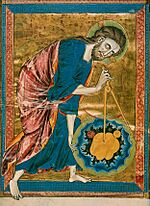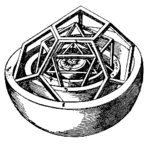List of geometers facts for kids
A geometer is a mathematician who studies geometry. Geometry is a branch of mathematics that looks at shapes, sizes, positions, and properties of space. Think of it as the study of everything from simple shapes like triangles and circles to complex 3D objects and even the shapes of the universe!
Geometers explore how shapes work, how they relate to each other, and how we can measure them. They use logic and special tools to understand the world around us in terms of lines, points, and surfaces.
Contents
What is Geometry?
Geometry is one of the oldest fields of mathematics. It helps us understand space and shapes. For example, when you build a house, design a car, or even play a video game, geometry is involved. It's used in art, engineering, computer graphics, and even understanding how light travels.
There are many types of geometry:
- Euclidean geometry is the most common type. It's what you usually learn in school, dealing with flat surfaces and shapes like squares and circles. It's based on the ideas of Euclid.
- Non-Euclidean geometry explores spaces that are not flat, like the surface of a sphere or a saddle.
- Analytic geometry uses coordinates (like on a graph) to describe shapes. This lets us use algebra to solve geometry problems.
- Projective geometry studies what happens to shapes when you project them onto a different surface, like shadows.
- Differential geometry uses calculus to study curved surfaces and spaces.
- Algebraic geometry combines algebra with geometry to study shapes defined by equations.
- Fractal geometry looks at complex, self-repeating patterns found in nature, like coastlines or snowflakes.
Famous Geometers Through History
Many brilliant thinkers have contributed to geometry over thousands of years. Here are some of the most famous ones and their big ideas.
Ancient Geometers (Before 1 AD)
Ancient civilizations like the Egyptians, Babylonians, and Greeks used geometry for building, land surveying, and astronomy.
- Pythagoras (around 570–495 BC) was a Greek mathematician. He is famous for the Pythagorean theorem, which helps us find the length of sides in a right-angled triangle.
- Euclid (around 300 BC) is often called the "father of geometry." His book, Elements, was the main textbook for geometry for over 2,000 years. It organized all the known geometry into a clear, logical system.
- Archimedes (around 287–212 BC) was a Greek scientist and mathematician. He made amazing discoveries about circles, spheres, and cylinders. He even figured out how to calculate the area and volume of many shapes.
Geometers of the Middle Ages and Renaissance (1–1800 AD)
During these periods, mathematicians from various cultures, including Islamic scholars, continued to develop geometry.
- Hero of Alexandria (around 10–70 AD) was a Greek engineer and mathematician. He developed formulas for finding the area of triangles and other shapes.
- Hypatia of Alexandria (around 370–415 AD) was a famous female mathematician and philosopher. She taught geometry and astronomy in Egypt.
- Omar Khayyam (1048–1131) was a Persian mathematician and poet. He used geometry to solve algebra problems, especially those involving conic sections (shapes like circles, ellipses, and parabolas).
- Leonardo da Vinci (1452–1519) was a famous artist and inventor. He used geometry in his art and designs, understanding perspective and proportion.
- Johannes Kepler (1571–1630) was an astronomer who used geometric ideas to describe how planets move around the sun.
- René Descartes (1596–1650) invented analytic geometry. This was a huge step, as it allowed mathematicians to use algebra to solve geometry problems by plotting points on a graph.
- Isaac Newton (1642–1727) was a famous English scientist. He used geometry in his work on gravity and motion.
- Leonhard Euler (1707–1783) was a Swiss mathematician who made many contributions to geometry and other areas of math.
 Leonardo da Vinci |
 Johannes Kepler |
 Girard Desargues |
 René Descartes |
 Blaise Pascal |
 Isaac Newton |
 Leonhard Euler |
 Carl Gauss |
 August Möbius |
Modern Geometers (1801–Present)
The 19th and 20th centuries saw geometry expand into many new and exciting areas, including non-Euclidean geometries and the study of higher dimensions.
- Carl Friedrich Gauss (1777–1855) was a German mathematician who explored curved surfaces. His work helped create differential geometry.
- Nikolai Lobachevsky (1792–1856) and János Bolyai (1802–1860) independently developed hyperbolic geometry, a type of non-Euclidean geometry where parallel lines can meet.
- Bernhard Riemann (1826–1866) developed Riemannian geometry, which is used in Albert Einstein's theory of relativity to describe the curved space-time of the universe.
- Felix Klein (1849–1925) organized different geometries using group theory, showing how they relate to each other.
- Henri Poincaré (1854–1912) was a French mathematician who worked on topology, which studies properties of shapes that stay the same even when they are stretched or bent. He also proposed the Poincaré conjecture, a famous problem in topology.
- Emmy Noether (1882–1935) was a German mathematician who made important contributions to algebraic topology, a field that combines algebra and topology.
- Benoit Mandelbrot (1924–2010) created fractal geometry. He showed how complex, beautiful patterns can be made from simple rules, and how these patterns appear in nature.
- William Thurston (1946–2012) was an American mathematician who made big advances in understanding 3D shapes and spaces.
- Grigori Perelman (1966–) solved the Poincaré conjecture, a very difficult problem that had puzzled mathematicians for over a century.
 Julius Plücker |
 Arthur Cayley |
 Bernhard Riemann |
 Richard Dedekind |
 Max Noether |
 Felix Klein |
 Hermann Minkowski |
 Henri Poincaré |
 Evgraf Fedorov |
H. S. M. Coxeter |
 Ernst Witt |
 Benoit Mandelbrot |
 Branko Grünbaum |
 Michael Atiyah |
 J. H. Conway |
 William Thurston |
 Mikhail Gromov |
 George W. Hart |
 Shing-Tung Yau |
 Károly Bezdek |
 Grigori Perelman |
 Denis Auroux |
Geometers in Art
Geometry isn't just for math class; it has inspired artists for centuries! Artists use geometric principles to create balance, perspective, and harmony in their works.
 God as architect of the world, a medieval image from 1220–1230. It shows God using a compass, a tool for geometry. |
 Kepler's model of the solar system from 1596. He used Platonic solids (perfect 3D shapes) to try and explain the distances between planets. |
 The Ancient of Days, 1794, by William Blake. The compass here is a symbol of divine order and creation. |
Newton (1795), by William Blake. This painting shows Isaac Newton as a "divine geometer," deeply focused on geometric problems. |
See also
- Mathematics and architecture


